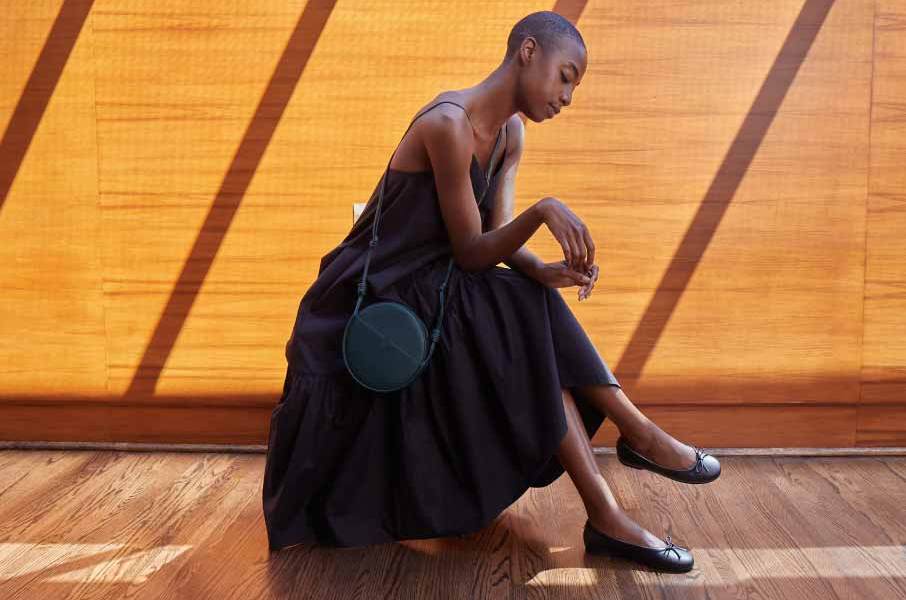Last week, the fashion industry doubled down on new alternative leather initiatives: Zara revealed a collection created in partnership with Ananas Anam, creator of the Pinatex material. And Stella McCartney launched a $200 million SOS Fund to support “cleaner businesses, founders and sustainable solutions” with material innovation, among other solutions. To date, McCartney’s fund has invested in vegan leather brand Bolt Threads, which created the brand’s first mycelium bag. Bolt Threads is one of the only companies to produce an alternative leather material that doesn’t rely on a plastic backing. The synthetic leather market was valued at around $63 billion in 2021 and is projected to reach $81 billion by 2028. The plastic synthetic leather segment accounted for the majority of the market’s revenue in 2021.
Meanwhile, material innovation company von Holzhausen and Italian luxury sneaker brand P448 are making use of leather alternatives with little to no plastic backing. For its part, von Holzhausen is formulating its alternative materials to match client needs while maintaining durability, a key problem with plastic leathers that recently came up with a Telfar bag. Bigger brands like Zara and Burberry now have the opportunity to produce less plastic and lower costs by implementing newly scalable alternative leathers.
California-based material innovation company von Holzhausen used its proprietary Banbū Leather to create the first landfill biodegradable leather ballet flat, priced at $295. Much like Pangaia, von Holzhausen, which is six years old, has developed a material innovation arm of the company to create a B2B business, giving other brands access to its three leather alternatives: Banbū leather, Technik leather and Struktur leather. It currently works with Apple, as well as undisclosed fashion brand partners.
At the moment, plastic-based vegan leathers, such as polyurethane and polyvinyl chloride, make up the majority of options. As plastic backings don’t biodegrade, they are harmful, contaminating the environment with chemicals and microplastic fibers. For instance, Zara’s Pinatex collection is comprised of 72% Pinatex, with plastic making up the rest.
“Our innovations are geared toward recycled content and very high plant-based content [that is] moving towards 100% plant-based content. We’re eliminating petroleum in all of our products,” said founder Vicki von Holzhausen, who previously worked as a car designer at Audi and Mercedes.
The company also recognizes that different prices can lead brands to choose more conventional plastic leather alternatives instead of considering more eco-friendly options.
“One thing that’s very unique about the way we work is we’re not offering one product to our customers,” said von Holzhausen. “Banbū leather, Technik leather and Struktur leather all have different inputs. Because of that, there are a variety of price points, so we can work with our customers in a modular way to hit their price targets.” While von Holzhausen did not disclose the company’s price range, she shared that its first shoes are one of its lower-priced items. Its B2B partners work in similar price points.
Ad position: web_incontent_pos1
Exotic leathers are also being replaced in the move to finding alternative hides that don’t impact the planet, with Burberry and Copenhagen Fashion Week banning them as of next season. As exotic leathers demand textural differences, they can be harder to replicate using materials like Mylo leather from Bolt Threads or von Holzhausen bamboo-based leather.
As the industry looks further for alternatives, invasive fish species like the lionfish have become a viable option, with material innovation company Inversa leading the market. The company worked with P448 to bring its lionfish exotic material to scale via $300 sneakers in five different colorways released on August 9. P448 is working to bring more leather alternatives into its range.
“Often, brands think by switching to an alternative leather they must give something up, whether it be the hand-feel, the texture or any true-leather qualities,” said Deepika Nagajaran, Inversa cmo. “We have been able to create an exotic leather alternative that is truly eco-positive without losing any of the qualities of true exotic leathers that the consumer appreciates. With supply availability, we consistently hear from brands that even if they are looking for alternatives, the waiting list is often years long. We have created a scaled supply chain and we are currently taking orders with a 2 month turnaround.” The company is also adding another fish leather, Dragonfin, later this year.
P448 currently has five different alternative leather material collections stocked on its site and in its stores, developed by its newly established sustainability division that is also tackling its supply chain.
While not a vegan solution, the invasive fish species used as a leather alternative would result in less waste than other options and would protect ecosystems without using plastic. “When you’re making things out of plant-based materials, like cactus or eucalyptus, it can take a lot of energy to turn the fruits into pulps before it is also mixed with plastic,” said P448 CEO Wayne Kulkin. “There has to be a more strategic way of educating the consumer versus just doing something that is only a bit better.”
Ad position: web_incontent_pos2
Nagajaran believes that there is more regulation coming for plastic leather, making alternatives a bigger market. “In the US, there is already regulation with the FDRC (Footwear Distributors & Retailers of America) that you must disclose plastic based “leather” as non-leather alternatives. Since it is misleading to call plastic-based materials “vegan”, we definitely expect there to be further development in regulations.”




